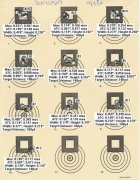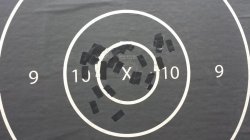michaelnel said:
This is unlikely to end well.
As with many unproductive discussions, that's because apples are being compared with oranges. I assume that Jerry is talking about agging in the 1s across a multi-day all-conditions short-range tournament. There are plenty of tournaments where a grand agg starts with a 1 for quite some distance down the list. Jim is giving the numbers for his world record aggs, and I'm betting that his 100-yard tests agging in the 1s are not multi-day all-conditions shooting.
If we compare apples to apples using records (see below), it's pretty clear that short-range benchrest records require
much smaller groups and aggs when expressed in MOA. There are many confounding factors, of course. E.g., conditions have a much greater effect in long-range BR, can't see bullet holes at 1K, much better flagging at short-range shoots, there are vastly more competitors and venues in short-range BR, and the list goes on. ANY of these records are impressive accomplishments and nobody is well served by suggesting otherwise.
IBS Light Gun 1Kyd 6-match agg = 3.072"
IBS Light gun 1Kyd small group = 1.397"
Short range bag gun 5-5 aggs (MOA):
IBS 5-5 agg 100yd: 0.1364
IBS 5-5 agg 200yd: 0.1602
IBS 5-5 agg 300yd: 0.1828
IBS 100yd group: 0.051" (NBRSA record 0.0077")
IBS 200yd group: 0.091" (NBRSA record 0.075")
IBS 300yd group: 0.240" (NBRSA record 0.149")
Of note is that ALL of the short-range group records are below 0.050 MOA, equivalent to a half-inch group at 1Kyd (not saying that a half-inch group at 1K is as easy as a 0.050" at 100yd). The record short-range aggs are roughly half the 1K record agg in MOA.
It seems to me that there is virtually no overlap between the top competitors in short-range and long-range BR. I would guess that the top shooters in either discipline could BECOME top shooters in the other discipline, because the mental game is very similar in both. Clearly both disciplines require great equipment and the ability to read/adjust to conditions.












